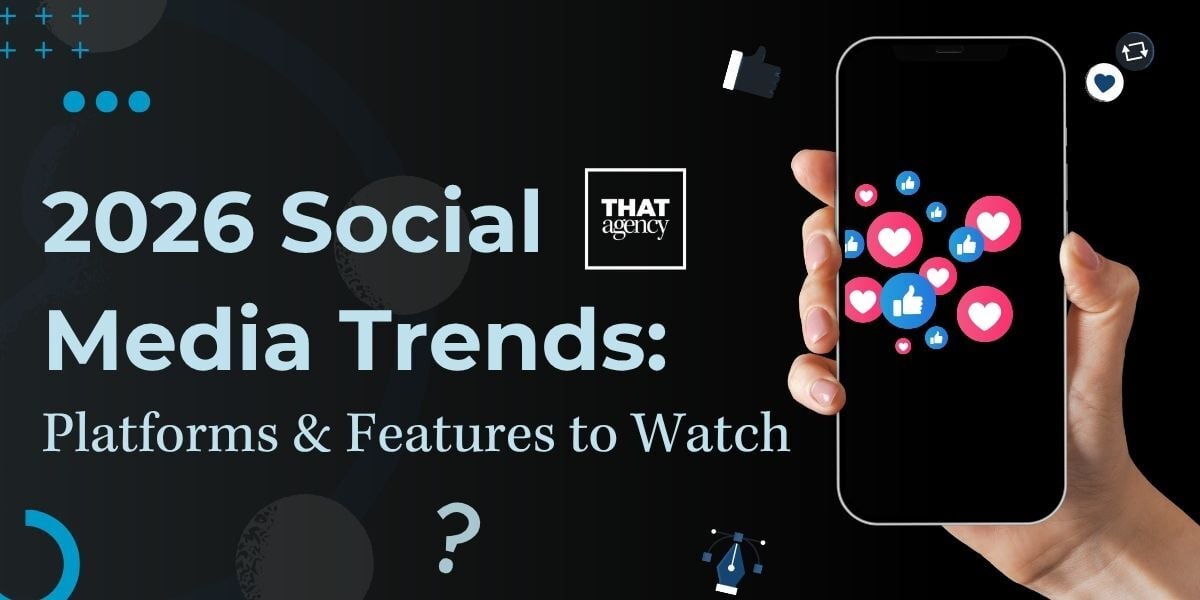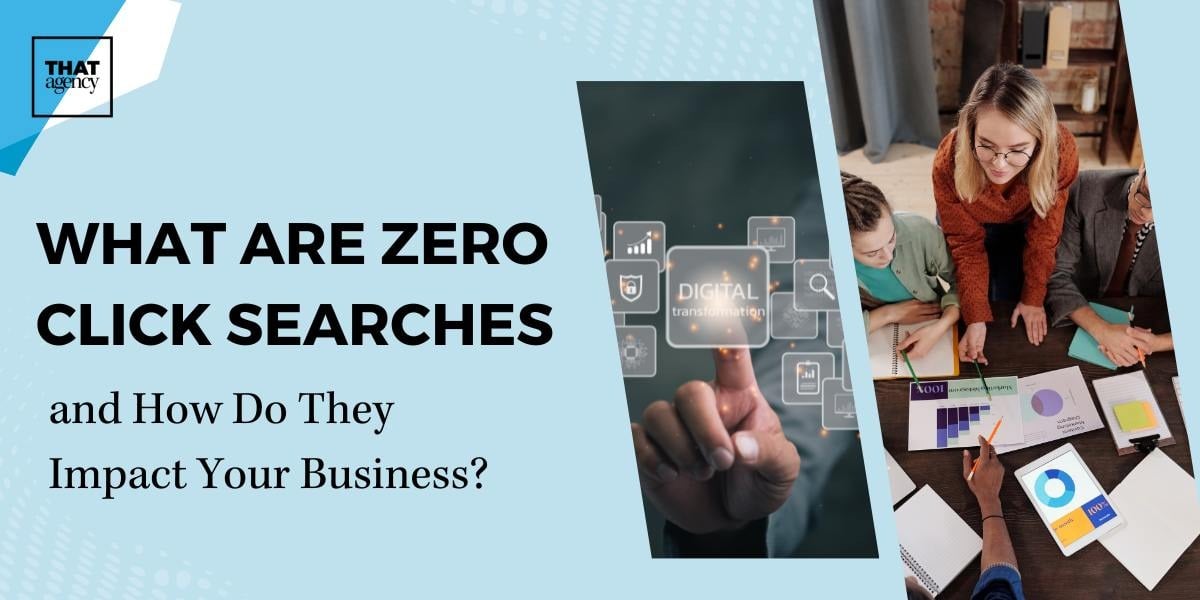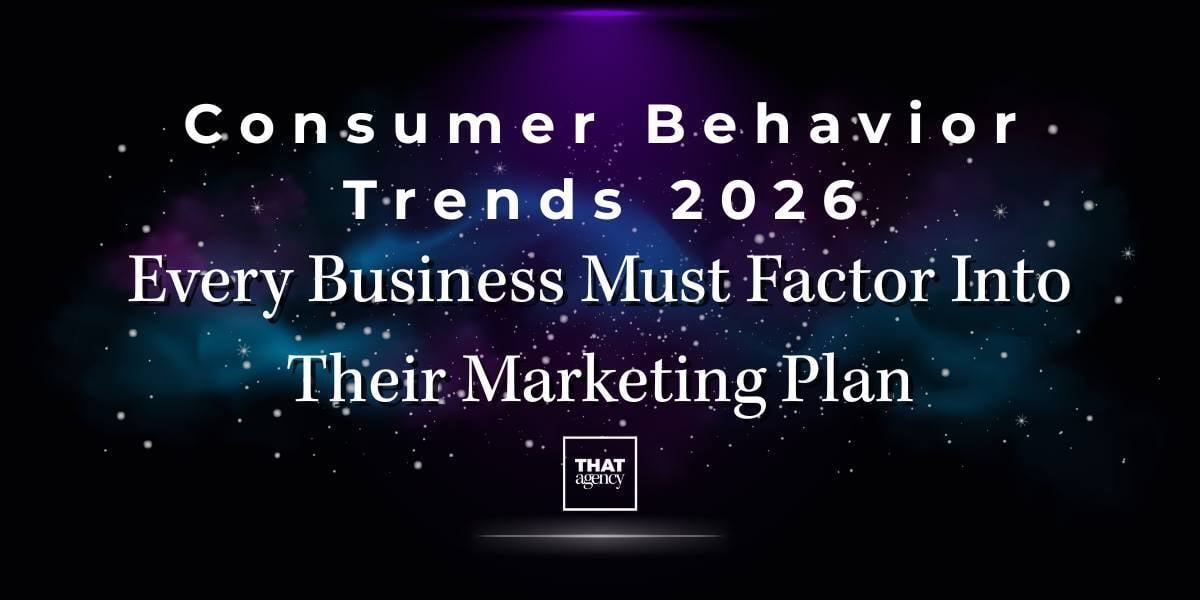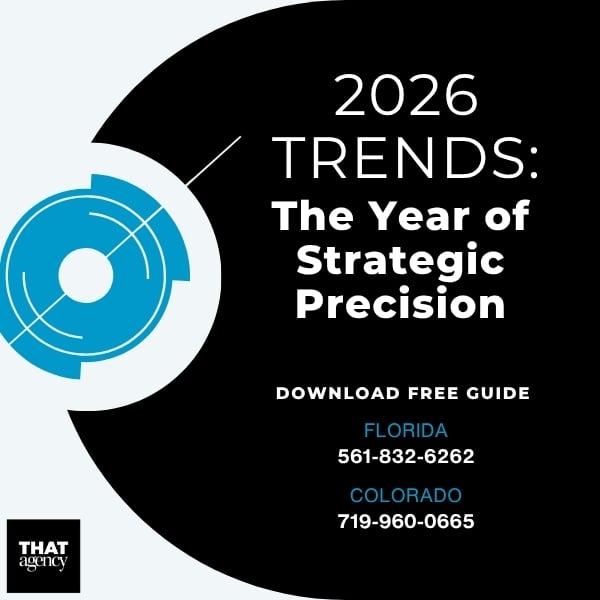Social media is changing fast, and 2026 is no exception. New features, smarter technology, and shifting user behavior are shaping what’s next. If you're a business owner, marketing director, or just trying to stay ahead online, you need to know what’s coming.
In this guide, we’re breaking down the most important 2026 social media trends and what they mean for your brand. We’ll also explore the future of digital marketing and the future of social media, how platforms are evolving and what users are expecting now. These trends aren’t just guesses, they’re based on how people are already using social media and where platforms are clearly headed.

Let’s dive in.
Social media in 2026 is starting to look a lot different than it did just a few years ago. It’s not just about likes and followers anymore, it’s about smarter technology, more meaningful content, and stronger connections.
So, what exactly is shaping the future of social media this year? Here are the biggest shifts every business and brand should be paying attention to:
In 2026, no two social media feeds look the same. Platforms like TikTok, Instagram, and even Pinterest are using advanced AI to learn your habits, what you watch, like, share, and even pause on. That means users are seeing content that feels more relevant and tailored to them than ever before.
Why does this matter for businesses? Because generic posts no longer cut it. If your content doesn’t speak directly to your target audience’s interests or needs, they’ll scroll right past it.
Stat to know: According to a 2025 study by Sprout Social, personalized content gets 3.6x more engagement than non-personalized posts.
What you can do:
You can also use AI marketing tools to personalize your content and target the right audience.
People are getting more selective about what they share, and who they share it with. Thanks to growing concerns about data security and AI surveillance, platforms are now giving users more control over their data.
New privacy tools in 2026 include:
Did you know? Over 70% of users say data privacy is a major factor in whether they trust a brand online (Pew Research, 2025).
Learn more about marketing effectiveness and how trust influences engagement.
What you can do:
In 2026, social media users don’t want to be sold to, they want to learn, laugh, and connect. That’s why creators (from big influencers to everyday voices) are the ones driving engagement.
Many platforms are now shifting their algorithms to favor content from real people. Even brand posts that feel too polished or scripted tend to get less traction.
Stat to know: Posts from creators see up to 4x more engagement than posts from brand pages (Influencer Marketing Hub, 2025).
What you can do:
Check out how luxury brands use social media to connect authentically with audiences.
AI isn’t just a buzzword anymore, it’s built into every part of social media. From auto-generating captions and hashtags to managing customer service chats and even creating ad copy, AI is making life easier for brands and users alike.
Some platforms are even using AI to summarize posts, create smart replies, and recommend when and where to post for the best reach.
Stat to know: In 2026, over 60% of businesses are using AI tools for at least one part of their social media strategy (Hootsuite, 2026).
What you can do:
Learn how to leverage AI integration in digital marketing for better results.
Here’s the big takeaway: the future of social media isn’t just about flashy videos or trendy filters. It’s about giving people something they actually care about. Whether that’s a helpful how-to video, a funny behind-the-scenes clip, or an honest product review, what matters most is authenticity.
Brands that show up in a real, helpful, and human way are the ones winning attention in 2026. People want to follow accounts that feel like a friend, not just a business trying to sell something.
Helpful tip: Try sharing stories from your customers, your team, or your community. Let people get to know the faces behind the brand.
The 2026 social media trends all point toward one clear direction: personalization, trust, and connection. With smart tools, evolving platforms, and a growing demand for realness, now’s the time to rethink your strategy and focus on what really works.
For more insights, explore our post on social media for your business.
If you still think TikTok is just for dance trends and funny skits, it’s time to take a second look. In 2026, TikTok has become one of the most powerful tools for searching, shopping, and learning, especially among Gen Z and younger millennials. It’s no longer just entertainment. It’s a discovery engine. Businesses using TikTok Ads Manager or influencer partnerships are seeing stronger engagement than ever.
Your content strategy here should mirror SEO principles, answer questions, use natural keywords, and include strong visuals. See also our post on SEO trends in 2026 to learn how AI and search behavior are connected.
TikTok now lets users search using images instead of words. Just snap a picture of something, a chair, a skincare product, even a book, and TikTok will find related videos. This is changing how people shop and find reviews. It’s fast, visual, and surprisingly accurate.
The For You Page (FYP) is smarter than ever. TikTok’s AI doesn’t just react to your likes, it now predicts what you want to see next based on how long you watch certain clips, your comments, and even how you swipe. Your feed can completely shift based on your behavior in just a few minutes.
While TikTok used to be all about short clips, the platform now supports videos up to 10 minutes. That gives creators more room for tutorials, step-by-step how-tos, product reviews, and deep dives. These longer videos are perfect for businesses that want to build trust and explain their value.
TikTok is now a major discovery channel, not just a place for brand awareness. People are using it to search for:
Here’s the stat: Over 40% of Gen Z uses TikTok to search for things before they use Google (DataReportal, 2025).
If your brand isn’t showing up in those results, you're missing out on potential customers who are ready to engage.
Instagram has gone through a major transformation. It’s still visual, still fun, but in 2026, it’s also a powerful ecommerce tool. The platform is doubling down on augmented reality (AR), personalized shopping, and short-form video to keep users engaged, and help them buy directly from the app.
Now, users can try on glasses, shoes, makeup, and even furniture virtually, without leaving their homes. This AR tech lets them see how something fits, looks, or matches their space in real-time.
Brands that use AR filters are seeing higher conversion rates because it removes the guesswork from online shopping.
Instagram has made it easier than ever to shop directly from content. While scrolling through Reels or tapping through Stories, users can now tap on a product and buy it, without ever leaving the app. This creates a seamless experience that makes impulse buying more likely.
Instagram’s algorithm is now curating product collections based on user behavior. If someone saves fitness gear or makeup tips, they’ll start seeing similar products, brand collabs, or Reels featuring those types of items.
Instagram isn’t just for branding anymore, it’s a full-on shopping platform. And it’s working.
Here’s the stat: Instagram Reels have a 22% higher engagement rate than regular video posts (Hootsuite, 2025). Reels are also being prioritized in Instagram’s algorithm, which means more eyes on your content.
Both TikTok and Instagram are being used like search engines now. That means your videos should answer questions, solve problems, and include terms your audience is typing in. Use keywords in your captions, alt text, hashtags, and even spoken words, AI is listening.
You can learn more about maximizing conversion opportunities in our guide to conversion rate optimization.
To drive even more visibility, brands should align their approach with insights from marketing analytics 2025—helping understand audience behaviors in real time.
LinkedIn used to be known as the place to find a job or polish up your resume. But today, it’s grown into something much bigger. In 2026, LinkedIn is one of the top platforms for B2B marketing, industry news, professional networking, and personal branding. If you're a business owner, marketer, or team leader, this is a platform you can't afford to ignore. Learn how to improve your B2B digital marketing strategy and attract high-value clients through thought leadership and micro-events.
LinkedIn now helps users write stronger, more engaging posts using built-in AI. Whether you’re sharing company updates, industry insights, or thought leadership content, LinkedIn’s writing assistant can suggest headlines, summaries, and even full post drafts that match your tone and audience.
This is especially helpful for professionals who know what they want to say but need a little help saying it clearly, or making it more engaging.
In 2026, LinkedIn has fully embraced the creator economy. Users can now access:
This means you don’t need a massive following to make a big impact. With the right strategy, even small brands can build authority and reach decision-makers directly.
LinkedIn has also upgraded its events platform. Now, you can host multi-speaker live panels, Q&A sessions, and virtual conferences, all without needing third-party software. These events are integrated into the LinkedIn feed, making it easier to promote and drive attendance.
Why it matters: These features allow B2B companies to build community, showcase expertise, and generate leads, right where their audience is already scrolling.
Yes, and in a big way.
Stat to know: Posts shared by employees get 2.8 times more engagement than those shared by company pages (LinkedIn, 2025). People trust people, not logos.
YouTube is still the go-to platform for video, but now it’s also smarter and more interactive. Whether you're a small business, a content creator, or a brand looking to build trust, YouTube offers powerful tools to connect with niche audiences, teach, sell, and grow. For insights on optimizing your video approach, explore our blog on 2024 video marketing trends.
No more guessing where to find the info you need in a long video. YouTube now uses AI to automatically break videos into smart chapters based on what’s being said. Each section is clickable, making it easier for viewers to jump to what they care about most.
This also boosts your visibility in search, since YouTube and Google now index those chapter headings for SEO.
Monetization is evolving. YouTube has rolled out “Super Thanks”, allowing viewers to tip creators during any video, not just live streams. This is a game-changer for businesses offering free tutorials, walkthroughs, or educational content. Even if you're not monetizing through ads, you can still earn directly from your community.
The YouTube Community Tab lets brands post polls, photos, updates, and behind-the-scenes content to keep followers engaged between video uploads. Think of it like a mini social feed inside your channel. It helps build a stronger connection with subscribers and boosts overall channel activity.
Absolutely. YouTube is one of the most powerful search engines in the world, second only to Google. People use it to learn, compare products, and explore services.
Stat to remember: 95% of YouTube viewers say they use the platform to learn something new (Google, 2025). If your brand can teach, show, or explain, it belongs on YouTube.
Many B2B brands are now embedding YouTube videos in LinkedIn newsletters, posts, and event pages. This combo works well, YouTube helps with reach, while LinkedIn helps with authority and leads.
Pairing YouTube content with content marketing strategy ensures your videos stay visible and drive engagement across multiple channels.
Short-form text platforms are evolving fast, and they’re not just for quick thoughts anymore. In 2026, Threads by Meta and X (formerly Twitter) are leading the charge, each offering something a little different. Whether you're sharing live event updates or building a loyal audience around niche interests, these platforms are shaping the future of real-time communication.
Long threads can be hard to keep up with, especially during fast-moving conversations. Meta’s Threads now uses AI to generate quick summaries at the top of long posts, making it easier to get the main idea without reading every single reply. This is especially helpful during events, breaking news, or trending discussions.
Both Threads and X have added tools that allow brands to share updates with select groups. Instead of posting publicly, you can now target content to followers in specific communities, subscriber-only groups, or invite-only audiences.
Why does this matter? It allows for more personal, focused conversations, and it helps brands share behind-the-scenes content, early product launches, or exclusive offers with their most engaged followers.
Audio content is making a comeback in 2026, and it’s more accessible than ever. Voice posts now come with real-time captions and translations, making them easier to use and understand across global audiences.
This is a great way to build brand trust and show authenticity, especially when you want to add a personal touch to announcements or thoughts that don’t need a polished graphic.
There’s no one-size-fits-all answer. It depends on your audience and content style:
Pro insight: Brands that post in real time during events see 48% higher engagement than those who wait and post later (Social Media Today, 2025).
Review our guide on social media marketing campaigns and the best ways to manage engagement across channels.
Pinterest has always been known as a great place for inspiration, recipes, fashion, home decor, and event planning. But in 2026, it’s doing a lot more than helping users pin pretty things. Thanks to AI and predictive discovery, Pinterest is becoming a smart search engine that understands what users want, even before they know it. Learn how to optimize pins with SEO-friendly descriptions from local SEO experts and boost discovery long after posting.
Pinterest’s new AI tools allow users to generate custom mood boards with just a short description. For example, type “boho living room with gold accents,” and the platform creates a board filled with matching styles, colors, and products.
This makes it even easier for users to go from inspiration to action, and for businesses to show up in highly personalized, intent-based searches.
Pinterest is now using machine learning to understand where users are in their lives and what they might need next. Whether someone is planning a wedding, buying a home, starting a business, or expecting a baby, Pinterest delivers content and products that match those moments.
This “life stage marketing” approach gives businesses a new way to target users based on their goals, not just their past behavior.
Pinterest isn’t just for lifestyle brands anymore. In 2026, B2B content is gaining ground, with categories like:
This makes Pinterest a surprisingly strong tool for educational content, lead generation, and even service-based businesses.
Absolutely. While lifestyle content still dominates, Pinterest’s search behavior is very intent-driven. People are looking for ideas, solutions, and how-to content, whether it’s for personal use or business goals.
Stat to know: Pinterest ads drive 2.3x higher conversion rates than other platforms in the home, beauty, and fashion spaces (Insider Intelligence, 2025), and B2B categories are catching up fast.
Unlike Instagram or TikTok, which are driven by trends and timing, Pinterest content often gets discovered months after it’s posted. This makes it one of the best platforms for long-term search visibility and evergreen traffic.
You don’t need to be on every big-name platform to make an impact. In fact, some of the most loyal and engaged audiences in 2026 are found on smaller, niche platforms that offer more community and less noise. While TikTok, Instagram, and YouTube still dominate the spotlight, these under-the-radar platforms are gaining serious ground. Check out 12 marketing tactics to build brand trust and maintain consistent visibility across emerging platforms.
So, what’s driving this trend?
People are craving authenticity, connection, and content that feels personal. Niche platforms deliver just that.
BeReal started as a casual photo-sharing app where users post unedited snapshots once a day. Now, businesses are jumping on board.
What makes it different? Brands can only post once every 24 hours, and it has to be real-time and unfiltered. There’s no scheduling, no filters, and no polish. This helps businesses show a more human side, whether it’s a behind-the-scenes shot of the team or a sneak peek at a product in development.
Why it matters: Today’s audiences are smart. They can spot overly polished ads from a mile away. Sharing raw, authentic content helps build trust, and that’s what drives long-term loyalty.
If you haven’t heard of Lemon8, now’s the time to take a look. Think of it as a visual platform that combines the inspiration of Pinterest with the scrollable content of TikTok.
It’s especially great for:
What sets Lemon8 apart is the depth of content. Posts often include detailed captions, links to products, and aesthetic layouts, making it perfect for brands that want to educate and influence, not just entertain.
Trend insight: In 2026, Lemon8 is seeing above-average engagement rates from users aged 18–34, especially those interested in beauty, home decor, and sustainable products.
In 2026, many brands are stepping away from chasing viral hits. Instead, they’re focusing on smaller communities with shared interests, like parenting groups, hobby forums, health circles, or location-specific chat spaces.
These micro-communities allow businesses to:
Tip for businesses: Use these platforms for beta testing, gathering early feedback, and growing community trust before scaling to bigger campaigns.
Yes, especially if you're in a competitive industry. Niche platforms help you stand out without spending big on ads, and they often have less algorithm competition. You can build a tight-knit audience that actually listens and responds.
Artificial Intelligence (AI) isn’t just a tool, it’s now an essential part of how brands create, plan, and publish content. In 2026, AI is helping businesses of all sizes save time, boost creativity, and personalize marketing like never before.
But here’s the thing: successful brands know that AI doesn’t replace the human touch, it enhances it.
Explore how businesses are adapting in AI integration in digital marketing and marketing strategy examples.
Platforms like Meta and TikTok now offer AI-powered ad builders. You can upload a product photo or feed, and the platform will automatically create ad versions, complete with copy, calls to action, and visuals that match your audience preferences.
These tools analyze:
Result: Brands using AI to generate creative assets are seeing 15–25% higher click-through rates compared to manually created campaigns (AdTech Forecast, 2026).
One of the most time-consuming parts of content creation? Writing captions. AI tools in 2026 can now write engaging captions based on your:
These tools use real-time data to improve your copy’s performance, like suggesting trending keywords or emojis (if your brand uses them).
Some companies are now using AI-generated influencers, digital characters that look and sound human. These virtual ambassadors can:
While this might not be for every brand, AI influencers are becoming popular in industries like fashion, fitness, and tech, especially for global campaigns that require consistent messaging across countries and time zones.
For SEO-driven brands, our post on semantic search explains how AI affects ranking and keyword strategy.
A lot.
Stat to know: 62% of marketers use AI tools at least once a week, and nearly 30% use them daily (Hootsuite, 2026). From writing captions to scheduling content to generating ad copy, AI is a time-saver.
Some of the savviest marketers in 2026 are combining these two trends, using AI to quickly create tailored content for specific niche audiences. This approach leads to better engagement and more meaningful brand loyalty.
In 2026, social media isn’t just for scrolling, it’s where shopping happens. What used to be a trend is now the norm. Social commerce has become the go-to way for people to discover, review, and buy products without ever leaving their favorite app.
Whether someone’s watching a skincare routine on TikTok, browsing fashion ideas on Instagram, or learning how to decorate their living room on Pinterest, they can now go from inspiration to checkout in seconds.
So, what’s changed? And how can your business keep up?
Learn how to maximize ROI through PPC strategies and paid search campaigns that drive in-app sales.
Shoppers no longer have to visit your website. Instagram, TikTok, YouTube, and Pinterest all support in-app purchases, and users are loving it. With just a few taps, they can view a product, check the price, and complete the purchase, all without switching apps or opening a browser.
This reduces friction, increases impulse purchases, and creates a smoother buying experience.
Fact to know: According to a 2026 Statista report, 78% of Gen Z shoppers say they prefer to buy products directly inside social apps rather than visiting external websites.
Remember QVC? Now imagine it on TikTok and Instagram, but with creators, limited-time offers, and direct links to buy.
Live shopping is booming. Brands are hosting weekly livestreams that feel more like entertainment than sales pitches. These events often include:
Audiences can comment, ask questions, and check out in real time.
Real-world tip: Brands that host live shopping events regularly report up to 40% higher conversion rates compared to traditional posts.
Now, when a user adds a product to their cart, social platforms suggest related items, bundles, or loyalty perks automatically.
Let’s say someone adds a pair of sneakers to their cart. The app might suggest matching socks, a cleaner spray, or even offer a discount for buying a second pair.
These upsells are powered by AI and help brands increase average order value without being pushy.
Stat to know: Smart cart technology has increased upsell success rates by 23% on Instagram and 31% on TikTok (Social Commerce Pulse Report, 2026).
You can also strengthen discovery with local SEO strategies to make your brand more visible when users search for products near them.
If you're not set up for social commerce yet, you're likely missing out on customers who are ready to buy right now.
Social shopping helps you:
If you sell physical products, especially in fashion, beauty, home decor, or wellness, the answer is yes. But even service-based businesses can benefit by:
In 2026, social commerce is expected to generate over $1.6 trillion globally, up from $992 billion in 2023 (Accenture, 2026). That means more people are browsing and buying in-app than ever before.
If your checkout process still requires jumping through hoops, now’s the time to make it simple, and social.
If you want to grow online in 2026, following the 2026 social media trends isn’t optional, it’s essential. These insights show that the future of digital marketing and the future of social media is faster, smarter, and focused on genuine connection. AI is making content creation easier, while users expect more value and less fluff. From social media marketing for businesses to AI-powered tools, now’s the time to stay ahead.
No matter your industry, there’s a place for your brand on these evolving platforms, if you’re willing to adapt. From AR filters on Instagram to niche communities on BeReal, there are more ways than ever to reach the right people at the right time.
Want help staying ahead of the curve? Contact THAT Agency today to fine-tune your social media strategy and make the most of these 2026 trends.
Tags: Social Media, social media marketing, Social Media Trends, social media engagement, AI in social media

What are Zero Click Searches and How Do They Impact Your Business?

What is Voice Search Optimization? +4 Tips for Voice Search

Leveraging Predictive Analytics Marketing for Smarter Decisions

Consumer Behavior Trends 2026 Every Business Must Factor Into Their Marketing Plan
.jpg)
AI Image Generation for Marketers: What’s Possible and What to Avoid
700 S. Rosemary Ave.
Suite 204-707
West Palm Beach, FL 33401
P: 561.832.6262
F: 561.832.7707

